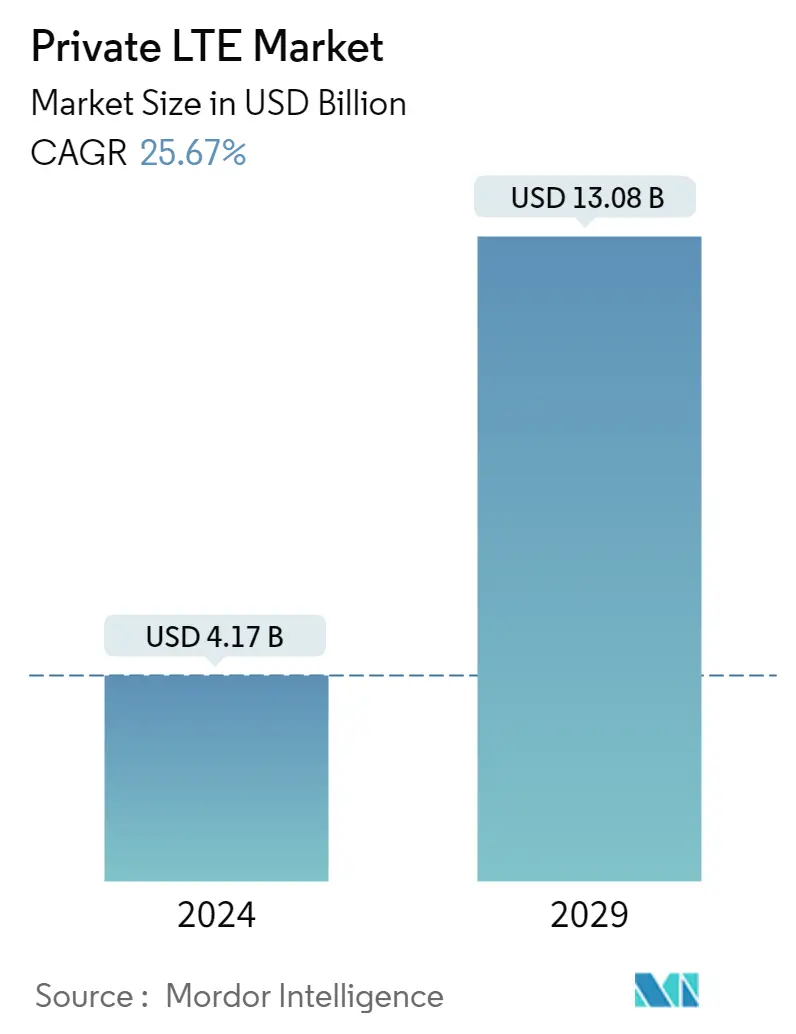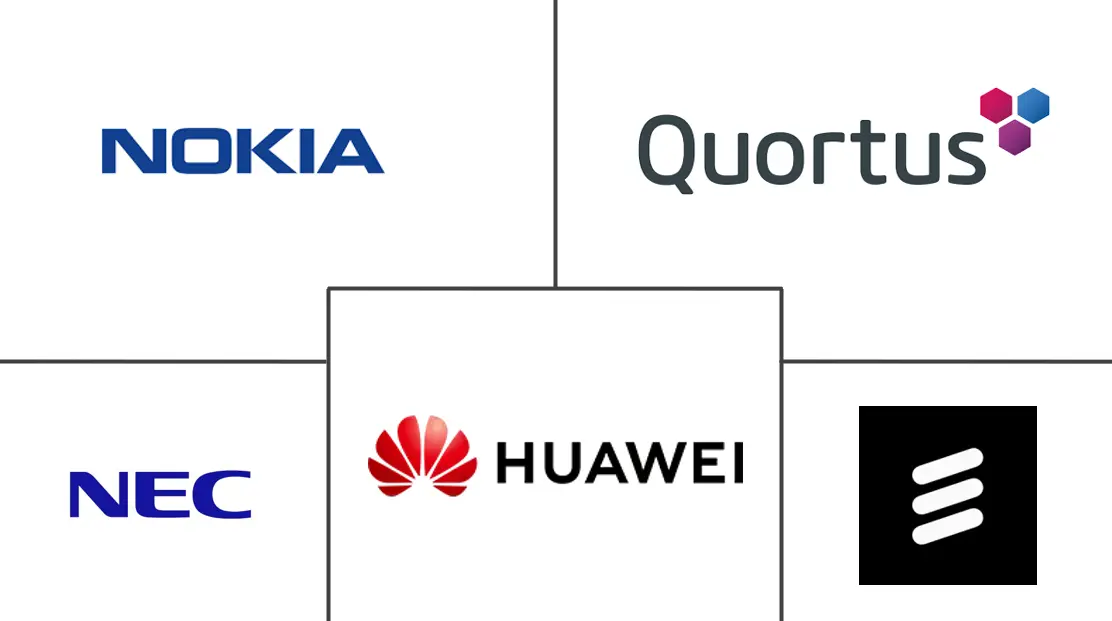Market Size of Private LTE Industry

| Study Period | 2019 - 2029 |
| Market Size (2024) | USD 4.17 Billion |
| Market Size (2029) | USD 13.08 Billion |
| CAGR (2024 - 2029) | 25.67 % |
| Fastest Growing Market | Asia-Pacific |
| Largest Market | North America |
| Market Concentration | High |
Major Players
*Disclaimer: Major Players sorted in no particular order |
Private LTE Market Analysis
The Private LTE Market size is estimated at USD 4.17 billion in 2024, and is expected to reach USD 13.08 billion by 2029, growing at a CAGR of 25.67% during the forecast period (2024-2029).
The availability of unlicensed spectrums like CBRS and MulteFire bands, as well as the growing adoption of private LTE networks, enable consumers to improve situational awareness, obtain more accurate information, and speed up response times. These factors are anticipated to contribute to the market's rapid growth throughout the forecast period.
- The development of private LTE networks is a result of the expanding need to convert heterogeneous, disconnected networks into smart linked systems in order to provide better customer contact and service delivery methods. Additionally, a private LTE network eliminates the limitations of a traditional network system, like Ethernet or Wi-Fi, by enabling both human and machine communication on a single network.
- The potential for a private LTE/5G network is gaining a lot of attention from suppliers, including infrastructure providers and mobile carriers, as well as from business purchasers across various industries. A vast number of applications and use cases are made possible by private LTE/5G networks, which can replace or supplement traditional network technologies.
- The widespread use of isolated systems is a primary factor driving private LTE networks. Private LTE networks provide benefits such as high speed, high capacity, high security, low latency, consistent performance, more extended range, and interoperability that support the demand necessary to achieve IIoT. The abovementioned factors are critical elements significantly affecting the private LTE market.
- Moreover, the automation Industry uses private LTE networks for various applications such as factory-floor robotics and logistics and warehousing (for pick and pack machines). Factory-floor robotics, logistics, and warehouse divisions also use private LTE. Due to these networks' growing advantages, they are increasingly being deployed for other users, such as transportation, mining, and enterprise IIoT applications.
- However, the specifications for private LTE/5G networks are complicated and highly individualized, making it challenging to expand the industry. Further, factors hindering the growth of private LTE are the complexity associated with implementing private LTE networks and constraints in terms of the requirement for an authorized license to deploy a private LTE network.
- COVID-19 had a mixed impact on the LTE market. In the initial stages of the epidemic, the market witnessed a decline in smartphone demand and reduced deployment of cell towers. However, in the further stages of the pandemic, the work-from-home culture and social distancing norms created a significant demand for the overall LTE market, especially private LTE, thereby witnessing rapid positive growth.
Private LTE Industry Segmentation
A private LTE network can be defined as a network that can cover a scaled-down version of a public cellular network using tiny cells, which are theoretically comparable to Wi-Fi access points. The market for the study defines the revenues accrued from the sales of LTE services offered by various vendors across multiple end-users, including Industrial (Public Safety, Supply Chain Management, Utilities, Manufacturing), Healthcare, and Enterprise.
The Private LTE Market is segmented by Component (Infrastructure, Services), Technology (Frequency-Division Duplexing (FDD), Time Division Duplex (TDD)), Deployment (Centralized, Distributed), Frequency Band (Licensed, Unlicensed, Shared Spectrum), End-user Industry (Industrial Public Safety, Supply Chain Management, Utilities, Manufacturing), Healthcare, and Enterprise) and Geography (North America, Europe, Asia-Pacific, and Rest of the World).
The market sizes and forecasts are provided in terms of value (USD million) for all the above segments.
| By Component | |
| Infrastructure | |
| Services |
| By Technology | |
| Frequency-Division Duplexing (FDD) | |
| Time Division Duplex (TDD) |
| By Deployment | |
| Centralized | |
| Distributed |
| By Frequency Band | |
| Licensed | |
| Unlicensed | |
| Shared Spectrum |
| By End-user Industry | |
| Industrial (Public Safety, Supply Chain Management, Utilities, Manufacturing) | |
| Healthcare | |
| Enterprise | |
| Other End-user Industries |
| Geography | ||||||
| ||||||
| ||||||
| ||||||
| Rest of the world |
Private LTE Market Size Summary
The Private LTE market is poised for significant growth, driven by the increasing demand for enhanced connectivity and the integration of disparate networks into cohesive systems. This market expansion is fueled by the availability of unlicensed spectrums like CBRS and MulteFire bands, which facilitate improved situational awareness and faster response times. Private LTE networks offer advantages over traditional systems, such as Ethernet or Wi-Fi, by enabling seamless communication between humans and machines on a single network. The growing interest from infrastructure providers, mobile carriers, and businesses across various sectors underscores the potential of private LTE/5G networks to replace or augment conventional technologies. These networks are particularly beneficial in industries like automation, transportation, and mining, where high speed, security, and low latency are crucial for applications such as factory-floor robotics and logistics.
The Asia-Pacific region is expected to be a key driver of market growth, with countries like China, Japan, and Australia leading the charge due to their robust manufacturing sectors and increasing adoption of IoT platforms. The region's economic growth and advancements in the telecom industry are encouraging investments in private LTE to enhance productivity and support Industry 4.0 initiatives. The market is characterized by consolidation, with major players like Nokia, Ericsson, and Huawei dominating through strategic mergers and acquisitions. These developments, along with partnerships such as Betacom's collaboration with Qualcomm, aim to provide comprehensive private network solutions. Despite the complexities and regulatory challenges in deploying private LTE networks, the market is set to expand significantly, supported by the rising demand for digital transformation and connected devices in industrial settings.
Private LTE Market Size - Table of Contents
-
1. MARKET INSIGHTS
-
1.1 Market Overview
-
1.2 Industry Value Chain Analysis
-
1.3 Industry Attractiveness - Porter's Five Forces Analysis
-
1.3.1 Bargaining Power of Suppliers
-
1.3.2 Bargaining Power of Buyers/Consumers
-
1.3.3 Threat of New Entrants
-
1.3.4 Threat of Substitute Products
-
1.3.5 Intensity of Competitive Rivalry
-
-
1.4 Assessment of the Impact of COVID-19 on the Market
-
-
2. MARKET SEGMENTATION
-
2.1 By Component
-
2.1.1 Infrastructure
-
2.1.2 Services
-
-
2.2 By Technology
-
2.2.1 Frequency-Division Duplexing (FDD)
-
2.2.2 Time Division Duplex (TDD)
-
-
2.3 By Deployment
-
2.3.1 Centralized
-
2.3.2 Distributed
-
-
2.4 By Frequency Band
-
2.4.1 Licensed
-
2.4.2 Unlicensed
-
2.4.3 Shared Spectrum
-
-
2.5 By End-user Industry
-
2.5.1 Industrial (Public Safety, Supply Chain Management, Utilities, Manufacturing)
-
2.5.2 Healthcare
-
2.5.3 Enterprise
-
2.5.4 Other End-user Industries
-
-
2.6 Geography
-
2.6.1 North America
-
2.6.1.1 United States
-
2.6.1.2 Canada
-
-
2.6.2 Europe
-
2.6.2.1 Germany
-
2.6.2.2 United Kingdom
-
2.6.2.3 France
-
2.6.2.4 Rest of Europe
-
-
2.6.3 Asia-Pacific
-
2.6.3.1 China
-
2.6.3.2 Japan
-
2.6.3.3 India
-
2.6.3.4 Rest of Asia-Pacific
-
-
2.6.4 Rest of the world
-
-
Private LTE Market Size FAQs
How big is the Private LTE Market?
The Private LTE Market size is expected to reach USD 4.17 billion in 2024 and grow at a CAGR of 25.67% to reach USD 13.08 billion by 2029.
What is the current Private LTE Market size?
In 2024, the Private LTE Market size is expected to reach USD 4.17 billion.

